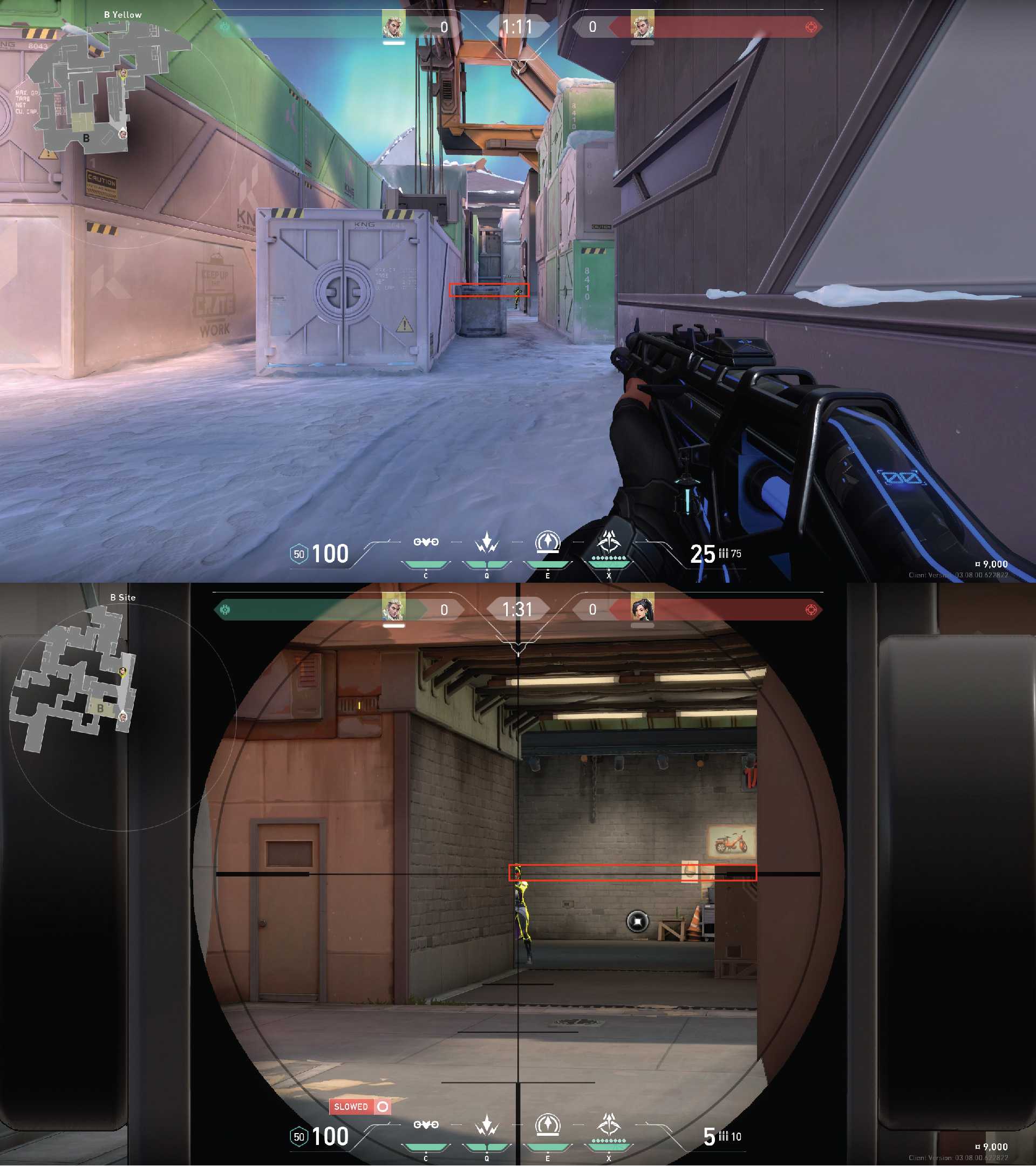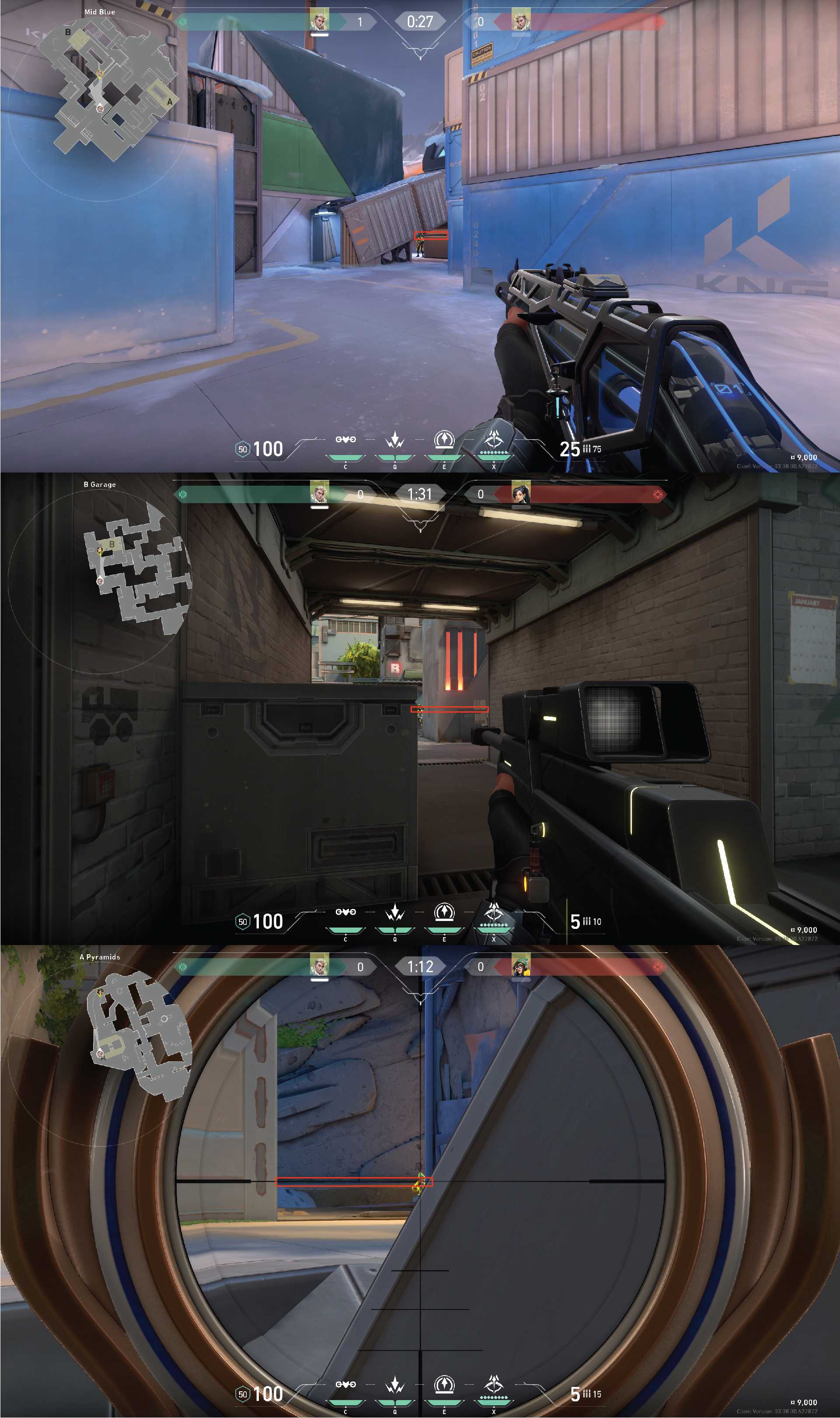Valorant’s developers have put so much thought and testing into their gameplay and map designs. So much attention to detail was added that they included design elements to subconsciously help players line up headshots against their enemies. For those having trouble picking up on hints; here are some design cues added in the maps to help you line your crosshair up for instant headshots. Please note that these design elements are true to even leveled lineups. You must adjust your crosshair based on vertical differences between you and the enemy on the map.
Using Boxes for Crosshair Placement
The first design element that is abundant on every map is the “box”. Boxes are found throughout the map from mid to spike sites. The boxes are strategically placed for cover and to create angles to play off of. There are a few types of boxes: wooden, metal and Radianite. All of them have the same dimensions, however they vary in wallbang ability. These boxes were made so that they barely cover the player using them to hide. So, if a player is hiding behind a box and you’re anticipating a swing, you can line your crosshair up with the top of the box. This makes it so that when the enemy swings, your crosshair is already in a favorable position. Here is an example of this with the different types of boxes found on every map.

Because of the way a single box is designed, you can use this design element to help you line up your crosshair with the various box formations. The most common box formations found throughout every map are double box structures and a structure known as “Tetris”. Tetris is a layout of boxes that usually feature three or more boxes. Because the top of a single box lines up with a player’s head, you would aim at the middle line in between a stack of two vertical boxes. This line stays true to the height of a player using it for cover. This can also be used for all materials the boxes are made out of. Examples of this are shown here:
Using Doors for Crosshair Placement
Another popular map element is the door. The maps Haven and Ascent both share similar doors. Both of the doors feature horizontal lines that run through it. In the middle of the lines is a bar of light. These lines are also used as a design feature to line up your crosshair with a player behind the door. In Haven, the door leads to Garage. You can use the middle line to line up your crosshair. In Ascent, there are doors on both A Site and B Site. They both have the same horizontal pattern. With these doors, you would line up your crosshair with the second line from the top.
Using Walls for Crosshair Placement
If there are no doors or doorways on a wall, it is still possible to use the actual wall to line up your crosshair for a shot. There are different wall features that help you place your crosshair when holding an angle or entering a site. One of the first wall features is the wall line. There are different types of lines found throughout each map, however they have the same characteristics. The first type of wall line you could use as a guide is what I call the generic “wall line”. These are lines in metal or stone walls that guide you to a hiding player’s head. These lines are easy to identify once you look for them. Here are a few examples of these lines.

There are different ornaments on walls that can also be used as a guide for crosshair placement. An example of this is shown here on Split. The wall on Ramp that you would see holding Heaven A is adorned with caution tape. This caution tape is placed so that when an enemy runs up the ramp, their head lines up with the tape. This is another example of a wallline that is shown through small designs in the map.
The second type of wall line that appears in every map is what I call a “wall split”. A wall split is usually a thick line, usually a strip of wood or metal that splits a wall into two different parts. Sometimes the bottom and top half are different colors, other times the strip of decoration separates two identical halves. An example of this is shown here on Ascent and Fracture.
Fracture’s A Site “wall split” shows that even though it looks like a box structure, the lines indicate that it has different dimensions than the regular boxes found on every map. For this structure you can use the top line on the wall to line up headshots of enemies hiding on site or even enemies to the left of site.
How to Recognize Other Map Cues for Crosshair Placement
Now that you are aware of a few design cues that are found on every map. You can start looking for even more elements that may show you where an enemy’s head is at. Make sure you notice the map and areas around you when you play (It took me months to realize that there was a giant mermaid mural on Breeze despite playing that map for so long). The more map awareness you have, the easier it is to find these elements to help your headshot aim. An example that I found while exploring these elements was when I noticed the bottom half of generator had the same height dimension as a box.
Another example that I found was the refrigerator in the back of Split’s B Site had the same height of a box as well. I used this in game to line up headshots against enemies hiding behind the wooden divider.
Once you start noticing the details within your environment, your crosshair placement will improve. So, grab your Vandal, Marshall, or Guardian and get those one-tap kills! Remember if an environment feature stands out to you, there’s probably a good reason it’s there.








